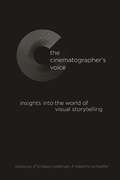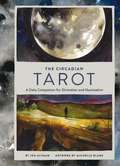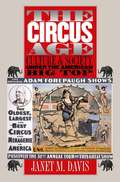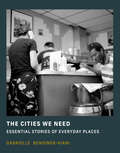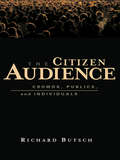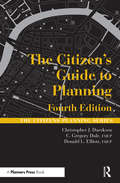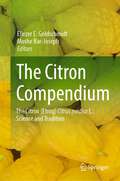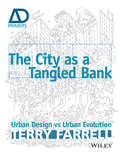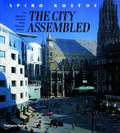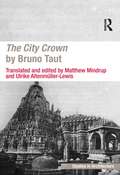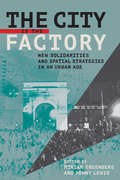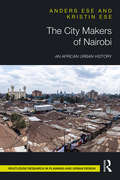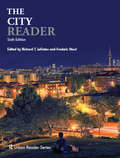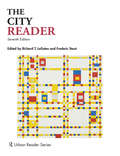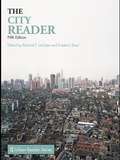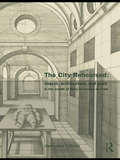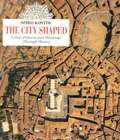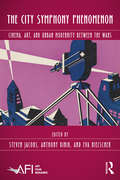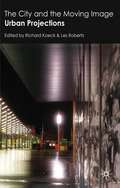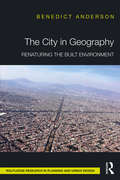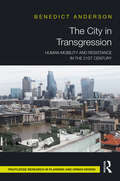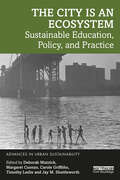- Table View
- List View
The Cinematic Tourist: Explorations in Globalization, Culture and Resistance (International Library of Sociology)
by Rodanthi TzanelliRecent years have seen a radical transformation of conventional tourist marketing and experience. The use of exotic locations in Hollywood films has allowed global audiences to enjoy distant places. Simultaneously, Hollywood screening of potential 'tourist paradises' has generated new tourist industries around the world. This book takes a closer look at this new phenomenon of 'cinematic tourism', combining theory with case studies drawn from four continents: America, Europe, Asia and Australasia. The author explores audiences' perceptions of film and their covert relationship with tourist advertising campaigns, alongside the nature of newly-born tourist industries and the reaction of native populations and nation-states faced with the commodification of their histories, identities and environments.
The Cinematographer's Voice: Insights into the World of Visual Storytelling (SUNY series, Horizons of Cinema)
by Lindsay Coleman; Roberto SchaeferThe Cinematographer's Voice is a unique exploration of contemporary filmmaking and cinematography. The distillation of more than one-hundred interviews with cinematographers from around the world, and the product of a decade's worth of scholarship, the book is not only a collection of interviews with some of the world's leading cinematographers, but also a panoramic sweep of what image-making means in the era of digital cinema. Frequently, cinematography may seem intimidating as a discipline, the preserve solely of practitioners who have learned, through years of exposure to photographic technology, both the required jargon and background knowledge to comfortably engage with an often-technical field. In our present era of film studies, this is no longer the case. The interviews collected here are informative not only on matters of technique, but also on the ways in which practitioners formulate their methodologies, work with directors, and engage with the many logistical hurdles of visual storytelling. The result is an oral history of the past forty years of filmmaking and the cinematography it has produced.
The Circadian Tarot
by Jen Altman Michelle BladeThis refreshingly contemporary take on Tarot is equal parts gorgeous art piece and thought-provoking spiritual touchstone. All 78 classic Tarot cards are represented, beautifully depicted in ethereal watercolors by Michelle Blade and eloquently explained in text by Jen Altman. The Circadian Tarot invites readers to start each day by reading a section at random (a technique known in the use of traditional Tarot decks as the single draw method"); the card thus revealed offers guidance for navigating hopes.
The Circus Age
by Janet M. DavisA century ago, daily life ground to a halt when the circus rolled into town. Across America, banks closed, schools canceled classes, farmers left their fields, and factories shut down so that everyone could go to the show. In this entertaining and provocative book, Janet Davis links the flowering of the early-twentieth-century American railroad circus to such broader historical developments as the rise of big business, the breakdown of separate spheres for men and women, and the genesis of the United States' overseas empire. In the process, she casts the circus as a powerful force in consolidating the nation's identity as a modern industrial society and world power.Davis explores the multiple "shows" that took place under the big top, from scripted performances to exhibitions of laborers assembling and tearing down tents to impromptu spectacles of audiences brawling, acrobats falling, and animals rampaging. Turning Victorian notions of gender, race, and nationhood topsy-turvy, the circus brought its vision of a rapidly changing world to spectators--rural as well as urban--across the nation. Even today, Davis contends, the influence of the circus continues to resonate in popular representations of gender, race, and the wider world.
The Cities We Need: Essential Stories of Everyday Places
by Gabrielle Bendiner-VianiAn expressive book of prose and photographs that reveals the powerful ways our everyday places support our shared belonging.Where would you take someone on a guided tour of your neighborhood? In The Cities We Need, photographer and urbanist Gabrielle Bendiner-Viani introduces us to the complex, political, and eminently personable stories of residents who answered this question in Brooklyn, New York, and Oakland, California. Their universal stories and Bendiner-Viani&’s evocative images illuminate what&’s at stake in our everyday places—from diners to churches to donut shops. In this culmination of two decades of research and art practice, Bendiner-Viani intertwines the personal, historical, and photographic to present us with placework, the way that unassuming places foster a sense of belonging and, in fact, do the essential work of helping us become communities.In this unique book, Bendiner-Viani makes visible how seemingly unimportant places can lay the foundation for a functional interconnected society, so necessary for both public health and social justice. The Cities We Need explores both what we gain in these spaces and what we risk losing as they are threatened by gentrification, large-scale development, and most recently the COVID-19 pandemic. Ultimately, Bendiner-Viani shows us how to understand ourselves as part of a shared society, with a shared fate; she shows us that everyday places can be the spaces of liberation in which we can build the cities we need.
The Citizen Audience: Crowds, Publics, and Individuals
by Richard ButschIn The Citizen Audience, Richard Butsch explores the cultural and political history of audiences in the United States from the nineteenth century to the present. He demonstrates that, while attitudes toward audiences have shifted over time, Americans have always judged audiences against standards of good citizenship. From descriptions of tightly packed crowds in early American theaters to the contemporary reports of distant, anonymous Internet audiences, Butsch examines how audiences were represented in contemporary discourse. He explores a broad range of sources on theater, movies, propaganda, advertising, broadcast journalism, and much more. Butsch discovers that audiences were characterized according to three recurrent motifs: as crowds and as isolated individuals in a mass, both of which were considered bad, and as publics which were considered ideal audiences. These images were based on and reinforced class and other social hierarchies. At times though, subordinate groups challenged their negative characterization in these images, and countered with their own interpretations. A remarkable work of cultural criticism and media history, this book is essential reading for anyone seeking an historical understanding of how audiences, media and entertainment function in the American cultural and political imagination.
The Citizen Journalist's Photography Handbook: Shooting the World As it Happens
by Carlos MillerWith dramatic and exciting stories, Carlos Miller reveals the secrets behind successful citizen journalism.Whether you're planning a publicity blitz for your cause, you're interested in the down-and-dirty practices of the police, or just want to be prepared for the moment you're the first on the scene, this book has everything you'll need to know to take newsworthy pictures and get them in front of a wide audience.You don't need a DSLR camera - though they can be useful - what is essential for citizen journalism is a cool head, an eye for a great angle, and the initiative to capture the moment: let Carlos Miller show you how.
The Citizen's Guide to Planning
by Christopher Duerksen Gregory C Dale Donald L ElliottAPA's popular primer for citizens is all new! For decades, planning officials and engaged citizens have relied on this book for a better understanding of the basics of planning. Now the authors have revised this perennial bestseller into a 21st-century guide for anyone who wants to make his or her community a better place. This book describes the land-use planning process, the key players in that process, and the legal framework in which decisions are made. The authors advocate principles and disciplines that will help those involved in the process make good decisions. In easy-to-understand language, they offer nuts-and-bolts information about different types of plans and how they are implemented. Chapters cover the goals and values of planning, the history of planning, the different people and organizations involved, the creation and implementation of a comprehensive plan, sustainability, the application review process, and legal and ethical questions.
The Citron Compendium: The Citron (Etrog) Citrus medica L.: Science and Tradition
by Moshe Bar-Joseph Eliezer E. GoldschmidtThis comprehensive book covers the theoretical and practical aspects of citron trees and fruit. The citron (Citrus medica L.), one of the three primary species ancestral to most citrus types, is used for traditional medicine and is highly revered in the Jewish religion during the Tabernacles feast, referred to by the name 'Etrog'. This book’s three sections address biology (botany, genomics, Chinese and Mediterranean citrons, diseases, pests, and horticulture), tradition (Talmudic discourse, mysticism, medicine, literature, art, food, and beverages) and history (archaeology, trade, grafting controversies); these sections are supplemented by a glossary and pictorial album. The 22 chapters, some new and some translated and considerably expanded from the 2018 Hebrew edition, were written by world-renowned specialists from Israel, Italy, France, the U.S.A., China and Australia. The book is written in an accessible scientific style aimed at a wide range of readers.
The City As A Tangled Bank: Urban Design versus Urban Evolution (Architectural Design Primer)
by Sir Terry FarrellHere Sir Terry Farrell, who has built an international career as an architect-planner, encourages other planners and architects to follow the biologists—look at, learn from, and, indeed, admire the nature of the forces that drive the change, and then with humility and respect work with them to nudge, anticipate and prepare for where it takes us. Searching for patterns within the apparent turbulence and complexity, he analyses the notions of urban design and urban evolution and examines whether or not they need necessarily be seen as opposing one another. The first two chapters discuss emergence as an idea in a biological and architectural context, as well as the distinction between urban design and planning in both education and practice, and the impact of other fields such as landscape design. Seven further chapters examine a range of themes embracing the importance of chain reactions in the progress of urban engineering; the character of habitation; layering; taste and context; adaptation and conversion; the advocacy of the architect-planner; and the effects of digital technology on city evolution. Farrell brings his considerable experience in practice to bear, elucidating his thoughts with examples from cities across the world, including Beijing, Hong Kong, London, New York, and Paris.
The City Assembled: The Elements of Urban Form Through History
by Spiro Kostof Greg Castillo Richard TobiasThe City Assembled is a history of the elements of cities: streets, public places, urban divisions (religious, political, and social), and the frontiers of city and countryside. Kostof follows the evolution of city components to modern times. He discusses "urban process": the effect on cities of natural disasters like the Great Fire of London and the Lisbon earthquake, war, and comprehensive redevelopment, compared with traditional patterns of growth and change. The current recovery from modernist extremes has made us look again at what we treasure in traditional urban life, and how we can recharge the old forms with contemporary common sense. Over 300 drawings, prints, paintings, and photographs help to tell the story, illustrating both patterns and uses, from the colonnaded streets of ancient Palmyra to gentrified London squares. A fitting testament to the wide-ranging intellect of Professor Kostof, The City Assembled is at once an exercise in architectural and social history, a case study for the present, and a pointer for the future. 346 illustrations, 40 in color.
The City Crown by Bruno Taut (Ashgate Studies in Architecture)
by Matthew Mindrup Ulrike Altenmüller-LewisThis book is the first English translation of the German architect Bruno Taut’s early twentieth-century anthology Die Stadtkrone (The City Crown). Written under the influence of World War I, Taut developed The City Crown to promote a utopian urban concept where people would live in a garden city of ’apolitical socialism’ and peaceful collaboration around a single purpose-free crystalline structure. Taut’s proposal sought to advance the garden city idea of Ebenezer Howard and rural aesthetic of Camillo Sitte’s urban planning schemes by merging them with his own ’city crown’ concept. The book also contains contributions by the Expressionist poet Paul Scheerbart, the writer and politician Erich Baron and the architectural critic Adolf Behne. Although the original German text was republished in 2002, only the title essay of The City Crown has previously been translated into English. This English translation of Taut’s full anthology, complete with all illustrations and supplementary texts, fills a significant gap in the literature on early modern architecture in Germany and the history of urban design. It includes a translators’ preface, introduction and afterword to accompany the original composition of essays, poems, designs and images. These original texts are accompanied by illustrations of Taut’s own designs for a utopian garden city of 300,000 inhabitants and over 40 additional historic and contemporary examples. The new preface to The City Crown explains the premise for the English translation of Taut’s anthology, its organization and the approaches taken by the translators to maintain the four different voices included in the original work. Matthew Mindrup’s introduction critically examines the professional and intellectual developments leading up to and supporting Bruno Taut’s proposal to advance the English garden city concept with a centralized communal structure of glass, the city crown. Through the careful examination of original
The City Is the Factory: New Solidarities and Spatial Strategies in an Urban Age
Urban public spaces, from the streets and squares of Buenos Aires to Zuccotti Park in New York City, have become the emblematic sites of contentious politics in the twenty-first century. As the contributors to The City Is the Factory argue, this resurgent politics of the square is itself part of a broader shift in the primary locations and targets of popular protest from the workplace to the city. This shift is due to an array of intersecting developments: the concentration of people, profit, and social inequality in growing urban areas; the attacks on and precarity faced by unions and workers' movements; and the sense of possibility and actual leverage afforded by local politics and the tactical use of urban space. Thus, "the city"—from the town square to the banlieu—is becoming like the factory of old: a site of production and profit-making as well as new forms of solidarity, resistance, and social reimagining.We see examples of the city as factory in new place-based political alliances, as workers and the unemployed find common cause with "right to the city" struggles. Demands for jobs with justice are linked with demands for the urban commons—from affordable housing to a healthy environment, from immigrant rights to "urban citizenship" and the right to streets free from both violence and racially biased policing. The case studies and essays in The City Is the Factory provide descriptions and analysis of the form, substance, limits, and possibilities of these timely struggles.ContributorsMelissa Checker, Queens College and the Graduate Center of the City University of New York; Daniel Aldana Cohen, University of Pennsylvania; Els de Graauw, Baruch College, City University of New York; Kathleen Dunn, Loyola University ChicagoShannon Gleeson, Cornell University; Miriam Greenberg, University of California, Santa Cruz; Alejandro Grimson, Universidad de San Martín (Argentina); Andrew Herod, University of Georgia; Penny Lewis, Joseph S. Murphy Institute for Worker Education and Labor Studies, City University of New York; Stephanie Luce, Joseph S. Murphy Institute for Worker Education and Labor Studies, City University of New York; Lize Mogel, artist and coeditor of An Atlas of Radical Cartography; Gretchen Purser, Maxwell School of Citizenship and Public Affairs, Syracuse University
The City Makers of Nairobi: An African Urban History
by Anders Ese Kristin EseThe City Makers of Nairobi re-examines the history of the urban development of Nairobi in the colonial period. Although Nairobi was a colonial construct with lasting negative repercussions, the African population’s impact on its history and development is often overlooked. This book shows how Africans took an active part in making use of the city and creating it, and how they were far from being subjects in the development of a European colonial city. This re-interpretation of Nairobi’s history suggests that the post-colonial city is the result of more than unjust and segregative colonial planning. Merging historical documentation with extensive contemporary urban theory, this book provides in-depth knowledge of the key historical roles played by locals in the development of their city. It argues that the idea of agency, a popular inroad to urban development today, is not a current phenomenon but one that has always existed with its many social, spatial, and physical ramifications. This is an ideal read for upper-level undergraduate and graduate students studying the history of urban development and theories, providing an in-depth case study for reference. The City Makers of Nairobi broaches interdisciplinary themes important to urban planners, social scientists, historians, and those working with popular settlements in cities across the world.
The City Reader (Routledge Urban Reader Series)
by Frederic Stout Richard T. LeGatesThe sixth edition of the highly successful The City Reader juxtaposes the very best classic and contemporary writings on the city to provide the comprehensive mapping of the terrain of Urban Studies and Planning old and new. The City Reader is the anchor volume in the Routledge Urban Reader Series and is now integrated with all ten other titles in the series. This edition has been extensively updated and expanded to reflect the latest thinking in each of the disciplinary areas included and in topical areas such as compact cities, urban history, place making, sustainable urban development, globalization, cities and climate change, the world city network, the impact of technology on cities, resilient cities, cities in Africa and the Middle East, and urban theory. The new edition places greater emphasis on cities in the developing world, globalization and the global city system of the future. The plate sections have been revised and updated. Sixty generous selections are included: forty-four from the fifth edition, and sixteen new selections, including three newly written exclusively for The City Reader. The sixth edition keeps classic writings by authors such as Ebenezer Howard, Ernest W. Burgess, LeCorbusier, Lewis Mumford, Jane Jacobs, and Louis Wirth, as well as the best contemporary writings of, among others, Peter Hall, Manuel Castells, David Harvey, Saskia Sassen, and Kenneth Jackson. In addition to newly commissioned selections by Yasser Elshestawy, Peter Taylor, and Lawrence Vale, new selections in the sixth edition include writings by Aristotle, Peter Calthorpe, Alberto Camarillo, Filip DeBoech, Edward Glaeser, David Owen, Henri Pirenne, The Project for Public Spaces, Jonas Rabinovich and Joseph Lietman, Doug Saunders, and Bish Sanyal. The anthology features general and section introductions as well as individual introductions to the selected articles introducing the authors, providing context, relating the selection to other selection, and providing a bibliography for further study. The sixth edition includes fifty plates in four plate sections, substantially revised from the fifth edition.
The City Reader (Routledge Urban Reader Series)
by Frederic Stout Richard T. LeGatesThe seventh edition of the highly successful The City Reader juxtaposes the very best classic and contemporary writings on the city. Sixty-three selections are included: forty-five from the sixth edition and eighteen new selections, including three newly written exclusively for The City Reader. The anthology features a Prologue essay on "How to Study Cities", eight part introductions as well as individual introductions to each of the selected articles. The new edition has been extensively updated and expanded to reflect the latest thinking in each of the disciplinary and topical areas included, such as sustainable urban development, globalization, the impact of technology on cities, resilient cities, and urban theory. The seventh edition places greater emphasis on cities in the developing world, the global city system, and the future of cities in the digital transformation age. While retaining classic writings from authors such as Lewis Mumford, Jane Jacobs, and Louis Wirth, this edition also includes the best contemporary writings of, among others, Peter Hall, Manuel Castells, and Saskia Sassen. New material has been added on compact cities, urban history, placemaking, climate change, the world city network, smart cities, the new social exclusion, ordinary cities, gentrification, gender perspectives, regime theory, comparative urbanization, and the impact of technology on cities. Bibliographic material has been completely updated and strengthened so that the seventh edition can serve as a reference volume orienting faculty and students to the most important writings of all the key topics in urban studies and planning. The City Reader provides the comprehensive mapping of the terrain of Urban Studies, old and new. It is essential reading for anyone interested in studying cities and city life.
The City Reader Fifth Edition
by Frederic Stout Richard T. LegatesThe fifth edition of the highly successful City Reader juxtaposes the best classic and contemporary writings on the city. It contains fifty-seven selections including seventeen new contributions by experts including Elijah Anderson, Robert Bruegmann, Michael Dear, Jan Gehl, Harvey Molotch, Clarence Perry, Daphne Spain, Nigel Taylor, Samuel Bass Warner, and others - some of which have been newly written exclusively for The City Reader. Classic writings from Ebenezer Howard, Ernest W. Burgess, LeCorbusier, Lewis Mumford, Jane Jacobs and Louis Wirth, meet the best contemporary writings of Sir Peter Hall, Manuel Castells, David Harvey, Kenneth Jackson. This edition of The City Reader has been extensively updated and expanded to reflect the latest thinking in each of the disciplinary areas included and in topical areas such as sustainable urban development, climate change, globalization, and the impact of technology on cities. The plate sections have been extensively revised and expanded and a new plate section on global cities has been added. The anthology features general and section introductions and introductions to the selected articles. New to the fifth edition is a bibliography listing over 100 of the top books for those studying Cities.
The City Rehearsed: Object, Architecture, and Print in the Worlds of Hans Vredeman de Vries (The Classical Tradition in Architecture)
by Christopher HeuerThe City Rehearsed offers an entirely new perspective on printed architecture in early modern Europe through the lens of Hans Vredeman de Vries. It probes the geographical encounters of dozens of engravings with contemporary texts on architecture, theatre, urbanism, art collecting, even ethnography. The Netherlandish polymath Hans Vredeman de Vries (1526-1609) devoted his entire career to the production of imaginary architecture. Painter, architect, rhetorician, perspective theorist, festival designer, and draughtsman, Vredeman was active in Antwerp, Amsterdam, and Prague, where he designed a mysterious body of architectural prints, works which by the seventeenth century had influenced buildings from Tallinn to Peru. Including Scenographiae (1560), and Perspective (1604-5), Vredeman’s strange publications were among the most widely-distributed "Renaissance" books on building and vision, shipped to England, Spain and even Mexico by 1600. This book, the first sustained study of Vredeman in English, shifts the focus of inquiry to look at the active role his prints played in the life of urban readers outside of a narrowly-defined "Flemish" architectural history. This is a study with clear interest for historians of art and the built environment, and one with broader contemporary resonances for changing definitions of "European" culture and identity in the present day.
The City Shaped: Urban Patterns and Meanings Through History
by Spiro KostofSpanning the ages and the globe, Spiro Kostof explores the city as a "repository of cultural meaning" and an embodiment of the community it shelters. Widely used by both architects and students of architecture, The City Shaped won the AIA's prestigious book award in Architecture and Urbanism. With hundreds of photographs and drawings that illustrate Professor Kostof's innovative ideas, this has become one of the most important works on urbanization.
The City Symphony Phenomenon: Cinema, Art, and Urban Modernity Between the Wars (AFI Film Readers)
by Steven Jacobs Eva Hielscher Anthony KinikThe 1920s and 1930s saw the rise of the city symphony, an experimental film form that presented the city as protagonist instead of mere decor. Combining experimental, documentary, and narrative practices, these films were marked by a high level of abstraction reminiscent of high-modernist experiments in painting and photography. Moreover, interwar city symphonies presented a highly fragmented, oftentimes kaleidoscopic sense of modern life, and they organized their urban-industrial images through rhythmic and associative montage that evoke musical structures. In this comprehensive volume, contributors consider the full 80 film corpus, from Manhatta and Berlin: Die Sinfonie der Grosstadt to lesser-known cinematic explorations.
The City and the Moving Image
by Les Roberts Richard KoeckThis edited collection explores the relationship between urban space, architecture and the moving image. Drawing on interdisciplinary approaches to film and moving image practices, the book explores the recent developments in research on film and urban landscapes, pointing towards new theoretical and methodological frameworks for discussion.
The City in Geography: Renaturing the Built Environment
by Benedict AndersonMonumental in scale and epic in development, cities have become the most visible and significant symbol of human progress. The geography on and around which they are constructed, however, has come to be viewed merely in terms of its resources and is often laid to waste once its assets have been stripped. The City in Geography is an urban exploration through this phenomenon, from settlement to city through physical geography, which reveals an incremental progression of removing terrain, topography and geography from the built environment, ushering in and advancing global destruction and instability. This book explains how the fall of geography in relationship to human survival has come through the loss of contact between urban dwellers and physical terrain, and details the radical rethinking required to remedy the separations between the city, its inhabitants and the landscape upon which it was built.
The City in Transgression: Human Mobility and Resistance in the 21st Century
by Benedict AndersonThe City in Transgression explores the unacknowledged, neglected, and ill-defined spaces of the built environment and their transition into places of resistance and residence by refugees, asylum seekers, migrants, the homeless, and the disadvantaged. The book draws on urban and spatial theory, socio-economic factors, public space, and architecture to offer an intimate look at how urban sites and infrastructure are transformed into spaces for occupation. Anderson proposes that the varied innovations and adaptations of urban spaces enacted by such marginalized figures – for whom there are no other options – herald a radical new spatial programming of cities. The book explores cities and sites such as Mexico City and London, the Mexican/US border, the Calais Jungle, and Palestinian camps in Beirut and utilizes concepts associated with ‘mobility’ – such as anarchy, vagrancy, and transgression – alongside photography, 3D modelling, and 2D imagery. From this constellation of materials and analysis, a radical spatial picture of the city in transgression emerges. By focusing on the ‘underside of urbanism’, The City in Transgression reveals the potential for new spatial networks that can cultivate the potential for self-organization so as to counter the existing dominant urban models of capital and property and to confront some of the major issues facing cities amid an age of global human mobility. This book is valuable reading for those interested in architectural theory, modern history, human geography and mobility, climate change, urban design, and transformation.
The City is an Ecosystem: Sustainable Education, Policy, and Practice (Advances in Urban Sustainability)
by Margaret Cuonzo Deborah Mutnick Carole Griffiths Timothy Leslie Jay M. ShuttleworthThe City is an Ecosystem maps an interdisciplinary, community-engaged response to the great ecological crises of our time—climate change, biodiversity loss, and social inequality—which pose particular challenges for cities, where more than half the world’s population currently live. Across more than twenty chapters, the three parts of the book cover historical and scientific perspectives on the city as an ecosystem; human rights to the city in relation to urban sustainability; and the city as a sustainability classroom at all educational levels inside and outside formal classroom spaces. It argues that such efforts must be interdisciplinary and widespread to ensure an informed public and educated new generation are equipped to face an uncertain future, particularly relevant in the post-COVID-19 world. Gathering multiple interdisciplinary and community-engaged perspectives on these environmental crises, with contemporary and historical case study discussions, this timely volume cuts across the humanities and social and health sciences, and will be of interest to policymakers, urban ecologists, activists, built environment professionals, educators, and advanced students concerned with the future of our cities.
The City of Domes
by John D. BarryA walk with an architect about the courts and palaces of the Panama Pacific International Exposition

